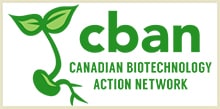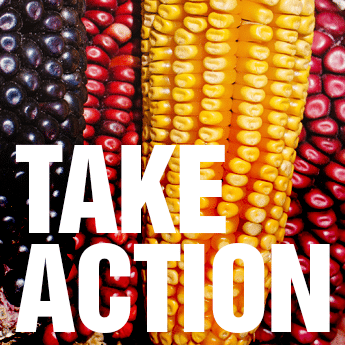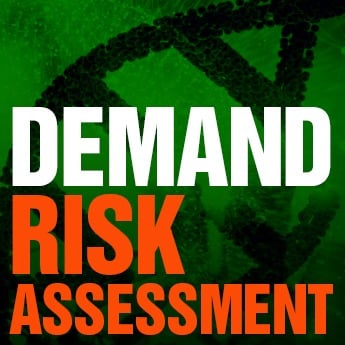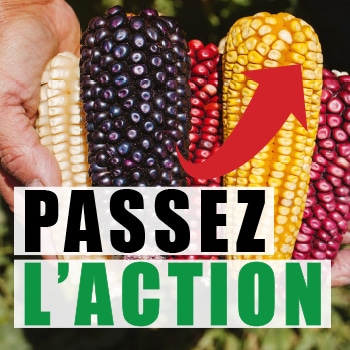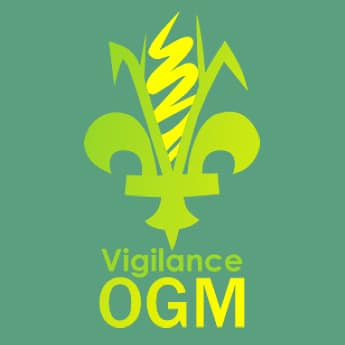June 15, 2018
There are no genetically engineered (genetically modified or GM) wheat varieties approved anywhere in the world. None have ever been commercially grown and sold. However, field trials of different GM wheat varieties continue in Canada and the US, at undisclosed locations.
Contamination from Monsanto’s GM herbicide-tolerant wheat
Monsanto’s GM trait for glyphosate-tolerance was found in wheat plants growing on a road in southern Alberta in 2017, in a contamination incident reported by Canadian regulators on June 14, 2018.[i]
There have been three GM wheat contamination incidents reported in the US (2013, 2014, 2016), all with Monsanto’s GM herbicide-tolerant (glyphosate-tolerant) “Roundup Ready” wheat.
In 2004, Monsanto withdrew its request for approval of its GM “Roundup Ready” wheat in Canada and the US after protests from farmers and consumers along with resistance in the international market.
The last time Monsanto grew trials of its GM wheat in Canada was in 2004 (2005 in the US).[ii]
GM Wheat Contamination in the US
There were three GM wheat contamination events reported in the US: in 2013, 2014 and 2016. All three were incidents with Monsanto’s GM herbicide-tolerant (glyphosate-tolerant) “Roundup Ready” wheat. The 2013 incident temporarily closed two export markets for US wheat.
July 2016: A farmer in Washington state discovered 22 of Monsanto’s GM glyphosate-tolerant wheat plants in an unplanted field.[iii] [iv] The variety had been tested in field trials in the Pacific Northwest 1998 – 2000.
September 2014: Monsanto’s GM wheat was found growing on a former trial site at a university research centre in Montana. It did not reach commercial channels.[v]
May 2013: The US Department of Agriculture (USDA) announced that a farmer in Oregon had found Monsanto’s GM wheat in her field.[vi] The USDA’s investigation concluded that the contamination was an isolated incident but that they were “unable to determine exactly how the GE wheat came to grow in the farmer’s field.”[vii]
- Japan and South Korea suspended imports of US wheat after the contamination was discovered.[viii] China, Thailand and the Philippines tightened inspections[ix],[x] and the European Union encouraged member countries to increase import testing.[xi]
- Monsanto paid over $2 million to settle lawsuits from US farmers who claimed that the company had failed to protect the wheat market from contamination. [xii]
GM Wheat Field Tests in Canada
The exact locations of experimental GM crop field trials are not disclosed in Canada (nor in the US). In Canada, the government discloses how many open-air trials are conducted in each province per year and identifies the crop type, the GM trait(s), and the name of the company running the test.
In 2017, there were 11 field trials of wheat varieties with “novel traits”, some or all of which could be genetically engineered, in Manitoba and 43 in Saskatchewan:
- In Manitoba: AgQuest (on contract for other companies); herbicide tolerance, selectable marker, fungal resistance
- In Saskatchewan: Bayer CropScience; herbicide tolerance, yield increase
In 2016, there were 3 field tests in Alberta, 7 in Manitoba, and 74 in Saskatchewan.
- In Alberta, Manitoba and Saskachewan: ICMS (Integrated Crop Management Service Inc); herbicide tolerance
- In Manitoba: AgQuest; herbicide tolerance, selectable marker, fungal resistance
- In Saskatchewan: Bayer CropScience; herbicide tolerance, yield increase
Field tests of wheat with “novel traits” in Alberta:
- 2017: 0
- 2016: 3
- 2015: 0
- 2014: 13
- 2013: 8
- 2012: 0
- 2011: 0
In July 2013, the Ottawa Citizen reported a 2012 containment breach at wheat research trials at Agriculture Canada’s Ottawa Experimental Farm by a flock of Canada Geese. The geese ate the GM fusarium-resistant wheat at the open-air site, possibly spreading viable undigested GM wheat seed through their droppings. [xiii]
The Cost of GM Contamination in Canada
In 2009, Canadian exports were found contaminated by a GM flax developed and approved in Canada but not in major export markets. It reached at least 35 countries that had not approved the GM flax.[xiv] The total cost of this contamination to the Canadian industry is estimated at $29.1-million.[xv] The source of the contamination was not determined. The GM flax was not grown commercially or sold on the market (In 2001, seed growers were multiplying 200,000 bushels of seed for future use but it was all crushed when the flax was taken off the market that year.) For details: www.cban.ca/flax or www.gmoinquiry.ca/farmers
For more information: www.cban.ca/wheat
Contact: Lucy Sharratt, Coordinator, Canadian Biotechnology Action Network coordinator@cban.ca 613 809 1103
[i] Canadian Food Inspection Agency, Detection of genetically modified herbicide-tolerant wheat in Alberta, June 14, 2018 http://inspection.gc.ca/wheatdetection
[ii] Canadian Food Inspection Agency, Plants with Novel Traits (PNTs) – Approved confined research field trials / Terms and conditions http://www.inspection.gc.ca/plants/plants-with-novel-traits/approved-under-review/field-trials/eng/1313872595333/1313873672306
[iii] Plume, Karl. 2016. USDA confirms unapproved GMO wheat found in Washington state. Reuters. Jul 29. http://www.reuters.com/article/us-wheat-washington-gmo-idUSKCN10920K
[iv] Monsanto Statement on Discovery of Glyphosate-Tolerant Wheat Plants in Washington State
https://monsanto.com/company/media/statements/statement-gmo-wheat-plants/
[v] Huffington Post. 2014. Unapproved genetically engineered wheat found in Montana research field: USDA. Sep 26. http://www.huffingtonpost.com/2014/09/26/genetically-engineered-wheat-montana_n_5889594.html
[vi] Goldenburg, Suzanne. 2013. US Department of Agriculture probes Oregon Monsanto GM wheat mystery. The Guardian. June 22. http://www.theguardian. com/environment/2013/jun/22/agriculture-oregon-monsanto-gm-wheat
[vii] USDA. 2014. USDA Announces Close and Findings of Investigation into the Detection of Genetically Engineered Wheat in Oregon in 2013. News Release. https://www.aphis.usda.gov/newsroom/2014/09/pdf/ge_wheat.pdf
[viii] Associated Press. 2013. Japan suspends some imports of U.S. wheat. The New York Times. May 31. http://www.nytimes.com/2013/05/31/business/global/japan-suspends-some-imports-of-us-wheat.html
[ix] Smith, Richard. 2013. S. Korea tightens inspection of imported winter white wheat. Capital Press. September 9. http://www.capitalpress.com/content/RS-Japan-wheat-060713
[x] Goldenberg, Suzanne. 2013. Asia curbs imports of wheat after genetically modified sample found. The Guardian. https://www.theguardian.com/environment/2013/may/31/genetically-modified-wheat-us-monsanto
[xi] Mufson, Steven and William Branigin. 2013. European Union urges testing of US wheat imports for unapproved strain. Washington Post. May 31. https://www.washingtonpost.com/business/economy/european-union-urges-testing-of-us-wheat-imports-for-unapproved-strain/2013/05/31/eaaefcdc-c9fc-11e2-8da7-d274bc611a47_story.html
[xii] Gillam, Carey. 2004. Monsanto settles farmer lawsuits over experimental GMO wheat, November 12. https://www.reuters.com/article/usa-monsanto-wheat-idUSL2N0T22O820141112
[xiii] Tom Spears. 2014. Access-to-information roadblocks: What’s in that wheat field? Ottawa Citizen. July 22. http://ottawacitizen.com/news/local-news/access-to-information-struggles-whats-in-that-wheat-field
[xiv] The Canadian Biotechnology Action Network monitored the European Commission’s Rapid Alert System for Food and Feed in 2009 for reporting of flax contamination. See www.cban.ca/flax
[xv] SJ Thompson, SJT Solutions. 2015. Investigating Value Added Potential of Flaxseed and Straw, Final Report Project for SaskFlax, February 23. http://www.saskflax.com/quadrant/m223edia/Pdfs/Research/150223_Final_Document_Flax_Value_Added.pd
